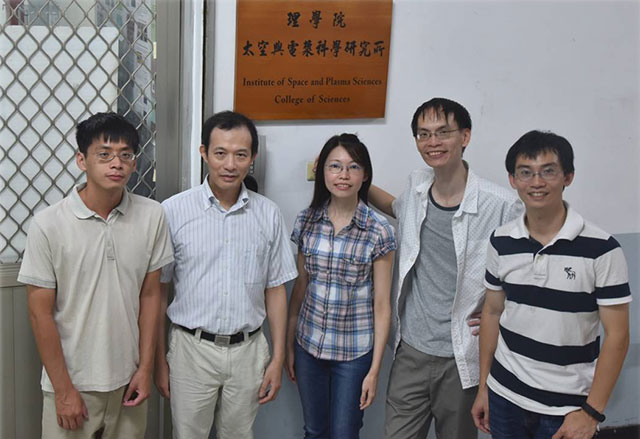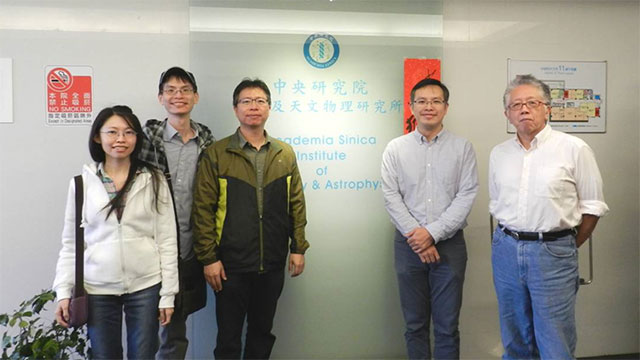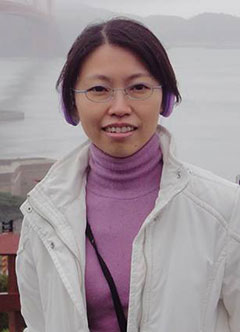Message for the ERG
Chang, Tzu-Fang
Institute of Space and Plasma Sciences, National Cheng Kung University, Taiwan
ERG mission (Exploration of energization and Radiation in Geospace) is the first formal space research exploration mission in which Taiwan has collaborated with ISAS/JAXA by delivering a particle instrument. For many years, Taiwan has already performed several campaigns to observe the Earth’s ionosphere. For the first time, Taiwan is competent to take charge of an advanced space instrument for participation in a JAXA-led magnetospheric mission-ERG mission. Through years of efforts, Taiwan has successfully delivered the Low-Energy Particle Sensor for Electron (LEP-e) for deployment on the ERG satellite. The LEP-e instrument is an analyzer which enables the ERG satellite to observe the energy distribution and density of low energy electrons surrounding the Earth. In Taiwan, the project is led by Academia Sinica Institute of Astronomy and Astrophysics (ASIAA) in partnership with National Cheng Kung University (NCKU).

LEP-e PI team in NCKU and members of Taiwan ERG Data Center
The primary task of the Taiwanese ERG team is to design and develop the LEP-e instrument hardware and perform data pipeline processing. The cooperative activities at NCKU are performed by Institute of Space and Plasma Sciences (ISAPS). As a researcher at ISAPS, my research subjects are about auroral/magnetospheric substorms, magnetosphere-ionosphere coupling and low-latitude nightglow variations. Since Academia Sinica (AS), the most preeminent academic institution in Taiwan, signed an agreement with ISAS/JAXA in 2014, the Taiwanese ERG team has been set up kicking off the development of the LEP-e instrument, and I have been one of the team members. Since I joined the project, I have participated in parts of the LEP-e instrument tests. My main task is about LEP-e data reduction pipeline and development of Taiwan ERG Data Center.
For the Taiwan-Japan collaboration on the ERG project, I have visited Japan ISAS/ JAXA and Tsukuba Space Center/JAXA to participate in environmental tests for the LEP-e instrument. Thanks to the great efforts of all the team members, we had LEP-e instrument completed and delivered for integration onto the ERG spacecraft. The team work has made significant strides in developing Taiwan’s capability in building advanced space instrument. During my visits, I realized that Japan can have huge potential for space development because of excellent space centers like JAXA. Japan also has excellent space science teams in universities. As a member of LEP-e PI team, I also visited the ERG Science Center team at Institute for Space-Earth Environmental Research (ISEE), Nagoya University, discussing the details of LEP‐e data processing. Efforts have been made in the tasks of data reduction pipeline. The LEP-e PI team is also responsible for providing the calibration parameters and program codes for ERG Science Center to apply the calibration parameters for Level 1 to Level 2 data processing. Through all the efforts, our tasks go beyond delivering the LEP-e instrument. At the moment, we are preparing for the establishment of Taiwan ERG Data Center, which will launch activities to promote the importance of the ERG project, dedicate to participation in research related to ERG mission, investigate the space weather and raise the interest of other Taiwanese space scientists in relevant research topics.
The LEP-e is one of the nine instruments to be onboard the ERG satellite. Every instrument is essential for the scientific goals of the ERG mission. The mission of ERG is scheduled to be launched in JFY 2016 and the event excites Taiwan’s space science community. Researchers in Taiwan are expecting to use the combined data from several instruments to address many scientific topics. For example: (1) by combining both the electron and ion measurements, the electron and ion acceleration mechanisms can be mutually compared to help identify the particle acceleration mechanism; (2) whether/how electrons are accelerated from low energy to high energy in the radiation belts or the high energy electrons are transported from outside into the radiation belts; (3) whether the low energy electron velocity distribution measured by LEP-e can produce the whistler waves with significant intensity; (4) whether/how the whistler waves can accelerate electrons to high energy; (5) whether/how high energy electrons are scattered by the whistler waves into loss-cone pitch angle and then lost to the ionosphere or they are transported by these waves out of the radiation belt. Since Taiwan’s FOEMOSAT-5 and FOEMOSAT-7 satellites are slated for launch in 2017, comparing ERG science data with observations of the upcoming FORMOSAT-5 and FOEMOSAT-7 satellites may allow scientists to study research topics about magnetosphere-ionosphere coupling.
Over the past 20 years, Taiwan’s space campaigns have been focusing on the ionosphere observations. It is the first time that a Taiwan-made advanced space instrument is to be deployed by a magnetospheric mission aiming at observing radiation belts. In particular, the Earth’s radiation belts are very critical for understanding the space weather of our geospace environment. There are many potentially adverse effects of anomalous space weather to our communication systems and space technology. If the LEP-e instrument can withstand the rigors of harsh environment in the radiation belts, it can be deployed in almost all space missions in the solar system. Thus, for Taiwan, it is a significant milestone to have the LEP-e instrument completed and delivered for integration onto the ERG spacecraft, and thus help achieve success of the ERG mission.
Together with the National Aeronautics and Space Administration (NASA) and European Space Agency (ESA), JAXA is one of the world’s major space agencies. From the perspective of Taiwanese ERG team, participation in the JAXA-led ERG project strikes a balance between cost and space development for a breakthrough that Taiwan wants to make. Through participating in the project, it allows Taiwanese scientists to personally join the LEP-e instrument tests and establish working relationships with Japanese experts in space technologies and space science. The practical experience of participation in the ERG project greatly benefits Taiwan’s space development. Taiwan gets to establish the heritage in the advanced space instrument development as well as specialist cultivation, key to reproducing experience of success in Taiwan. The heritage via practical experiences-rooted in Taiwan-has been mostly desired over more than 20 years during which Taiwan has invested much in space development. Taiwan should have long-term perspective and goals in space technology and science, including facilities establishment, human resources of specialist development and management, etc.
It relies on the cooperation of Taiwan’s most preeminent academic institution and one of the famous national universities so that Taiwan has got to participate in the ERG project. Taiwan’s academic communities have made joint efforts to work on the JAXA-led ERG project, through which to achieve the goal of promoting Taiwan’s space development. We deeply appreciate ISAS/JAXA providing the opportunity of Japan-Taiwan collaboration on the ERG project. Paving the way for future international opportunities in space research, Taiwanese participation in the ERG project has become an excellent example in Taiwan. Through the ERG mission, it is the first time that a Taiwan-made particle instrument is to cruise in the magnetosphere exploring the regions of intense ionizing radiation and monitoring the essential regions that affect our space weather. It allows Taiwanese scientists to access ERG data and increases world-class space research opportunities, and strengthens Taiwan’s capability in building top-notch instruments for future space science missions. The ERG mission is about to help unravel the complicated physics of the Van Allen radiation belts and help monitor the space weather to protect our environment and modern technologies. It is the final moments before launching the ERG spacecraft. With all the blessings, we are expecting the ERG satellite to have a successful launch and a fruitful operation.

ASIAA team

ASIAA team
 Chang, Tzu-Fang |
About me:I was born and grew up in Hualien City, the capital of mountainous Hualien County, Taiwan. It sits on an alluvial fan, facing the Pacific Ocean and leaning against the majestic mountains. It only took ten minutes to get to my grandparents’ house, which was located on the seashore. My brothers and I used to play on the beach searching for special stones or shells. I remember staring at the shimmering ocean surface, keenly aware that the vastness of the ocean was beyond my imagination. As waves continuously rolled onto the beach, the beauty and the power of nature have deeply rooted in my heart. |